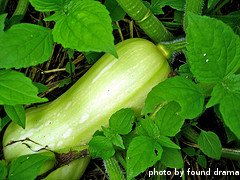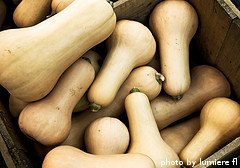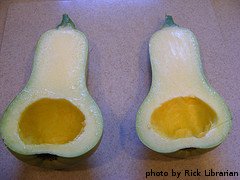Harvesting Butternut Squash
When it comes to harvesting butternut squash, the best way to tell if the squash are ready to be picked is by their appearance. If you pick them too early, the texture will be too firm and the sugars will not be developed. If you wait too long to harvest, the squash will be too mushy.

When butternut squash first appear on the vine, they will have green vertical lines on them. As the squash matures, the lines begin to fade and the rind turns to a pale orange, brown or tan color, depending on the variety.
Most butternut squash matures when it is 8-12 inches long. However, the length can vary depending on the growing conditions and variety. Some varieties produce squash that is easily twice that size. Nutrient rich soil will typically help produce larger squash, but the biggest determining factor in their size is which variety they are. Watch the squash carefully every day or so and monitor their lengths. When the squash stop growing, they typically are almost ready to be picked.
Another good way to tell if it's time for harvesting butternut squash is the appearance of the stem. When the squash is mature, the stem end will turn from green to brown. It will appear that the stem is beginning to dry out. When this happens, the plant slowly stops transferring nutrients into the squash. This is an indication that your butternut squash is ready to be picked and has the highest sugar content possible.

Finally, test the toughness of the rinds with your fingernail. If they resist being punctured, the squash are ready to be picked.
As the growing season winds down, you might find that there are factors that can affect when you harvest your butternut squash. For example, if a hard freeze is expected, it's better to go ahead and harvest the fruit, even if it's night quite fully ripe. This squash will still be fine to eat, it just won't have a highly developed flavor and sugar content like it would if it was fully mature. Another example is oftentimes toward the end of the growing season, pests like cucumber beetles and squash bugs can become a real problem in your butternut squash patch. In this case, look for signs that the pests are starting to infiltrate the squash themselves. Look for signs like small holes in the squash or softness at the stem end. If you see these indications, go ahead and harvest the squash, even if it's still not quite mature. It's better to error on the side of caution and end up with a few more moderately bland squash that are still edible and useable, instead of just letting the garden pests destroy all of your hard work.
To harvest butternut squash, use shears or a sharp knife to cut the squash from the vine, leaving about an inch of stem attached. Try your best to make a clean cut, to minimize the damage to plant. Wipe the dirt off the squash with a dry cloth, but don't wash them if you are planning to store them long term. The squash can then be stored for up to 2-3 months in a cool, dark place such as a basement, crawl space or root cellar. They will also last for up to 14 days at room temperature on a kitchen table or counter. When carrying the squash, don't hold them by the stem as you can risk it breaking off. A squash with a broken stem won't keep nearly as long and should be used within a few days.
You can also peel the squash, dice them and boil them until soft. The pieces can then be pureed or mashed and frozen in an airtight container for up to 6 months. When we want to freeze butternut squash, we like to cut it in half lengthwise, scoop out the seeds and roast it off in the oven. We then scoop out the flesh and put it in Ziploc bags, filling up each bag about 2/3 full. We lay the bags flat in the freezer and once they are fully frozen, we stack up the bags like books on a shelf in our freezer. You can also use the squash to make a soup, which can also be frozen or canned for later use.
After the growing season is over, you can pull the plants from the ground and add them to your compost pile. We like to chop them up first, usually with a weed whacker.
Now that you know about harvesting butternut squash, it's time for a few of our favorite recipes....

Click here for some of our favorite butternut squash recipes
Click here to move from our Harvesting Butternut Squash page to our Growing Butternut Squash main page
Click here to return to our Home page